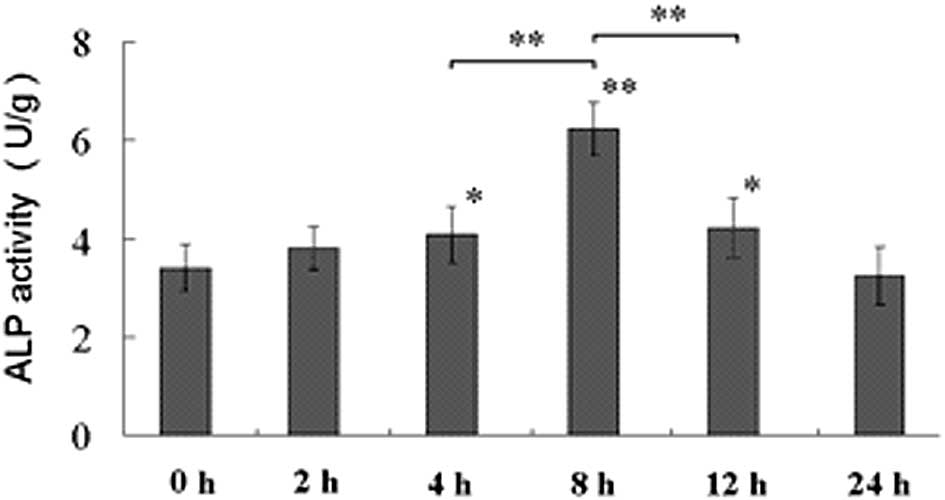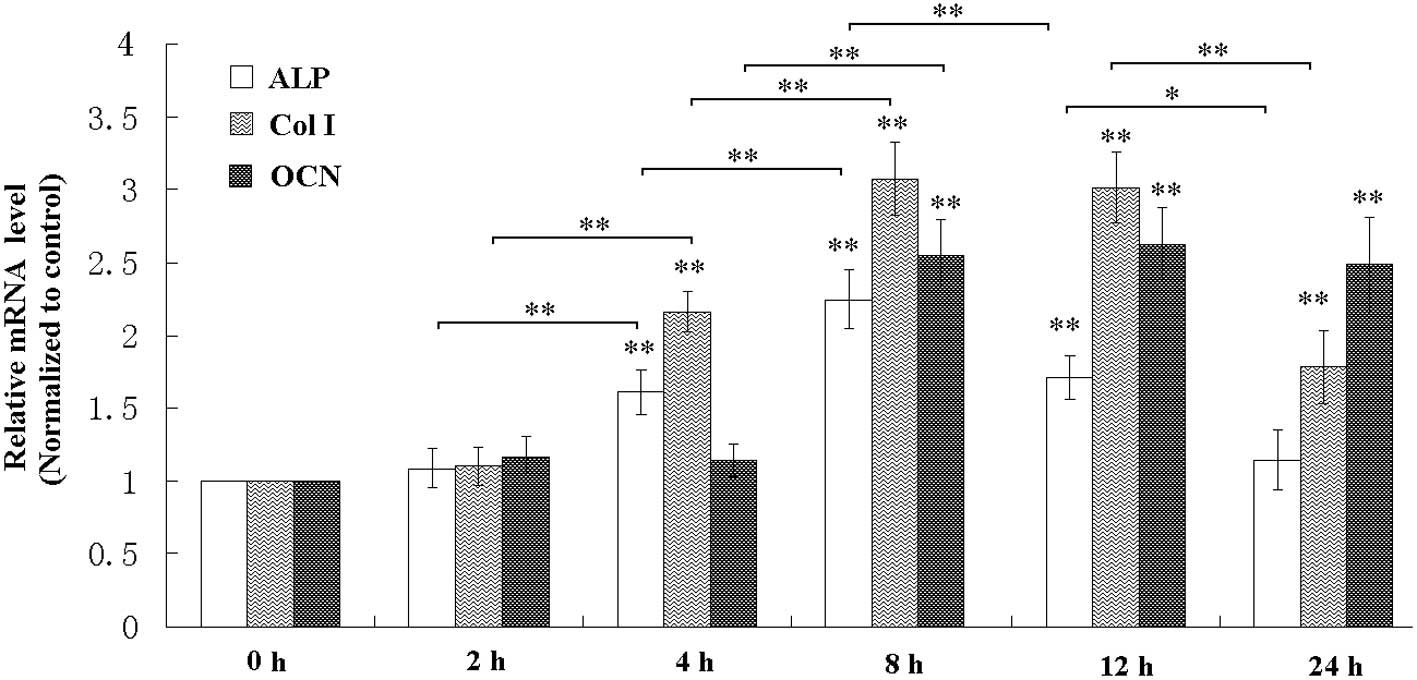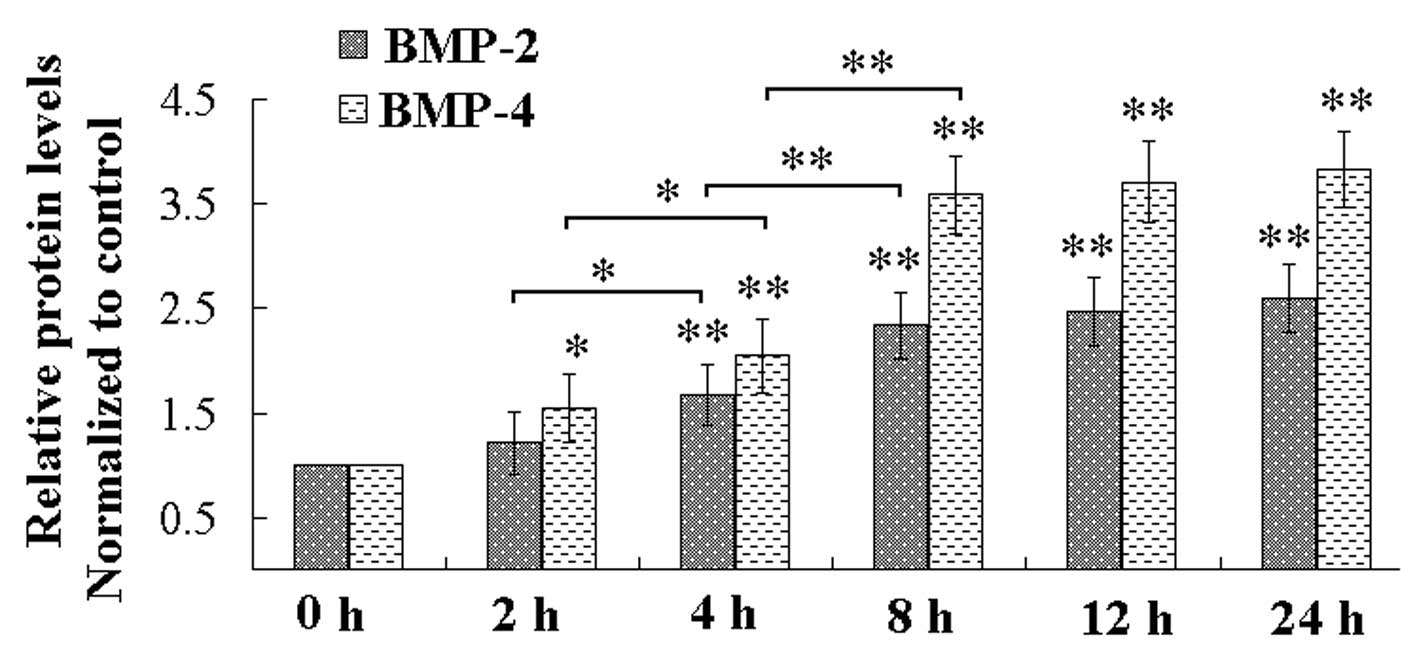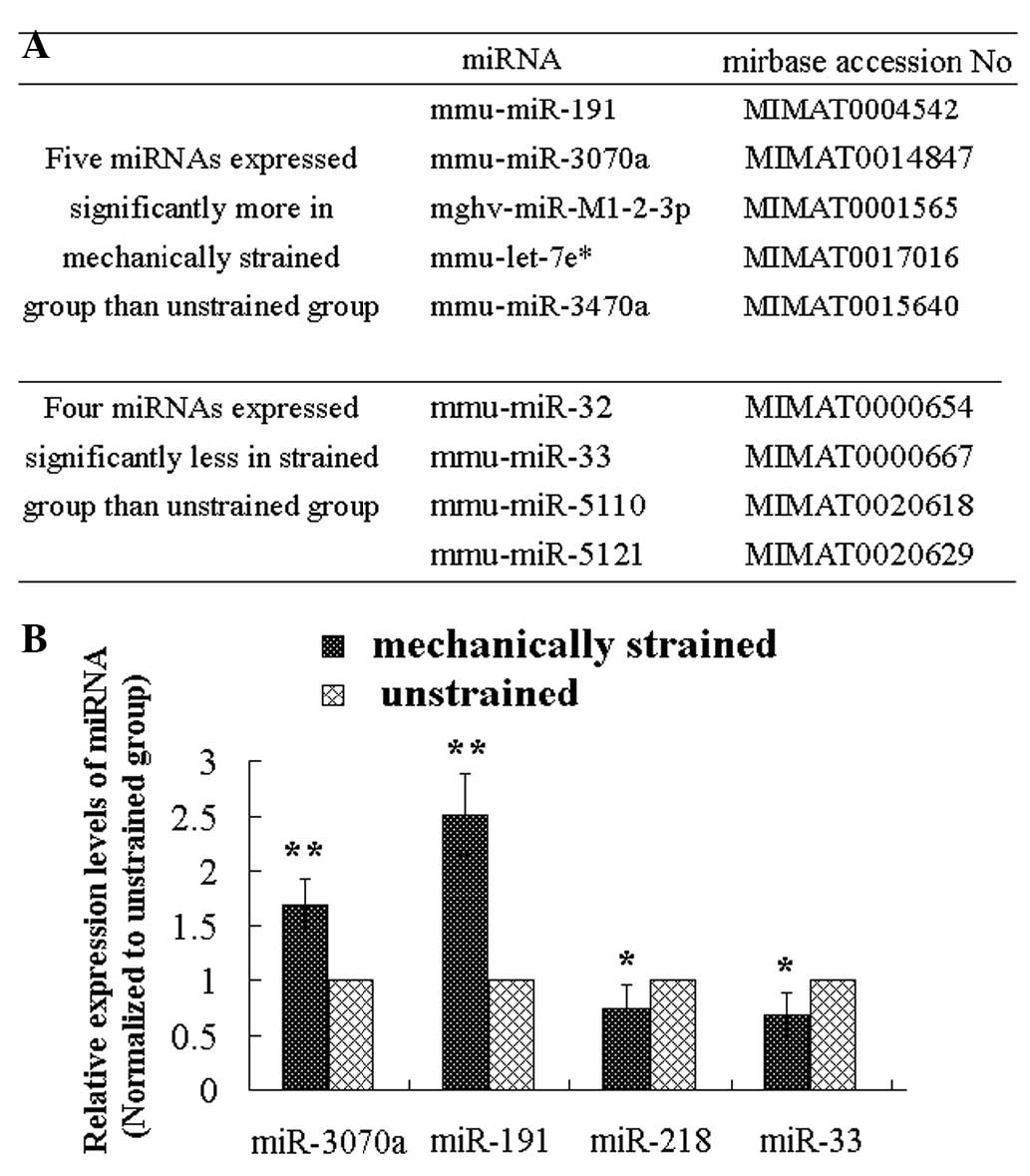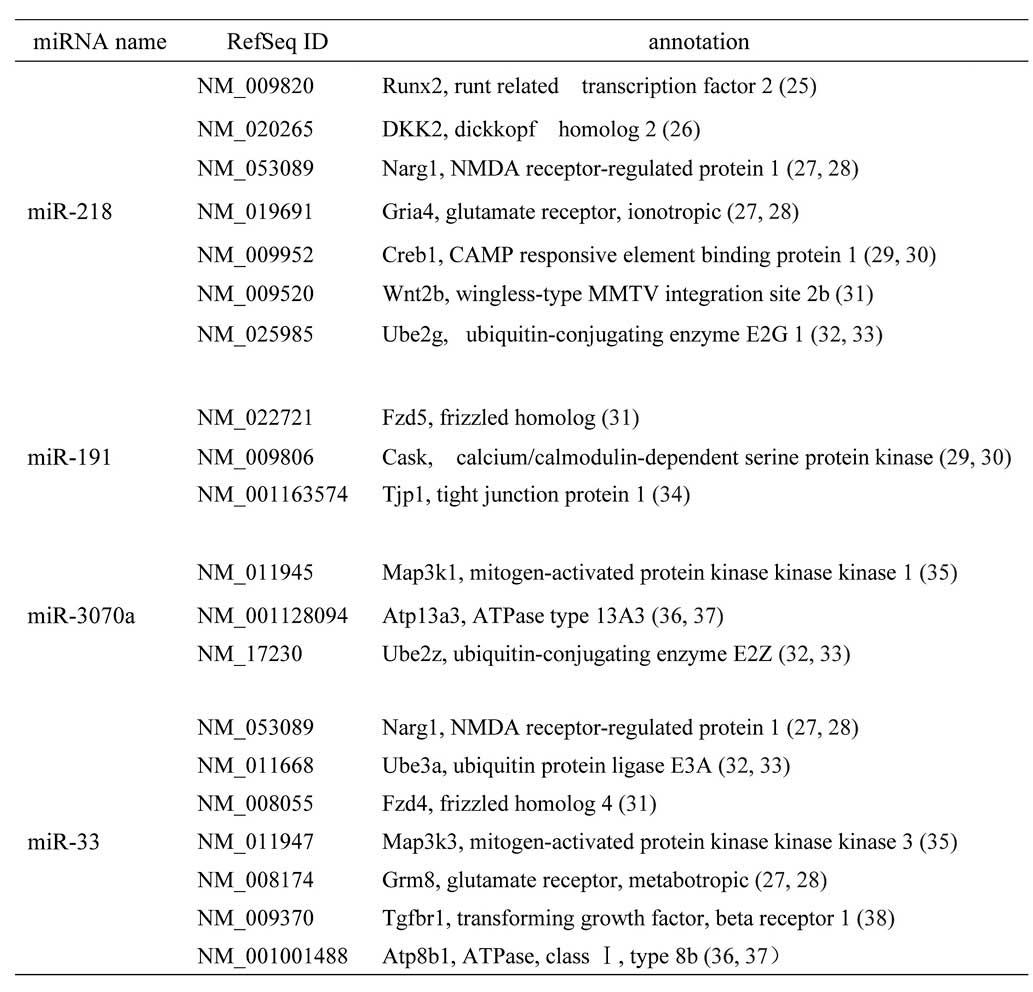MicroRNA-218, microRNA-191*, microRNA-3070a and microRNA-33 are responsive to mechanical strain exerted on osteoblastic cells
- Authors:
- Published online on: April 30, 2015 https://doi.org/10.3892/mmr.2015.3705
- Pages: 3033-3038
Abstract
Introduction
Mechanical strain is pivotal in bone remodeling as physiological dynamic loading promotes bone formation, whereas the absence of mechanical forces results in bone loss (1,2). In bone tissue, osteoblasts are important mechanical receptors, which can transform mechanical stimuli into biochemical signals for bone matrix formation and mineralization (3). Previous studies have demonstrated that mechanical forces are crucial regulators of osteoblastic proliferation, differentiation and apoptosis (4,5). However, the mechanism underlying the response of osteoblasts to mechanical strain remains to be fully elucidated, particularly the role of microRNAs (miRNAs; miRs) in the mecchano-response.
miRNAs are a class of small non-coding RNAs, typically 18–22 nucleotides in length, which repress gene expression at the post-transcriptional level by degrading their target mRNAs or through translational repression (6,7). miRNAs regulate cell proliferation, differentiation and apoptosis, and control physiological changes, including growth and development (6–8). Several miRNAs, which regulate bone formation or osteoblastic differentiation, have been found (9,10).
In previous years, certain mechanoresponsive or mechanosensitive miRNAs have been detected and identified in endothelial cells, chondrocytes and smooth muscle cells (11–13). For example, in mechanical strained chondrocytes, miR-365 is expressed at higher levels compared with unstrained cells, and regulates chondrocyte differentiation (12). Osteoblasts are a type of mechanoresponsive cell, therefore, the present study hypothesized that they contain mechanoresponsive miRNAs.
In the present study, mouse pre-osteoblastic MC3T3-E1 cells were stimulated with mechanical tensile strain, which was performed to stimulate osteoblastic differentiation. Subsequently, miRNA microarray and reverse transcription-quantitative polymerase chain reaction (RT-qPCR) analyses were performed to identify the presence of mechanoresponsive miRNAs.
Materials and methods
Application of mechanical strain to cultured cells
The MC3T3-E1 cells (provided by the Institute of Basic Medicine of Peking Union Medical College, Beijing, China), a mouse pre-osteoblastic cell line, at the third passage, were seeded into mechanical loading dishes, which were reformed from cell culture dishes (Nunc International, Roskilde, Denmark) in α-minimal essential medium (Invitrogen Life Technologies, Carslbad, CA, USA), supplemented with 10% fetal bovine serum (FBS) and 1% penicillin-streptomycin (Invitrogen Life Technologies).
At confluence, the medium was replaced with FBS-free medium, and the MC3T3-E1 cells were subjected to mechanical tensile strain of 2,500 με at 0.5 Hz for different durations (0, 2, 4, 8, 12 and 24 h). The mechanical strain was generated by a specially designed four-point bending device (Institute of Medical Equipment, Academy of Military Medical Sciences, Tianjin, China), as previously described (14).
ALP activity assay
Following the induction of mechanical strain, the MC3T3-E1 cells were lysed by brief sonication on ice in radioimmunoprecipitation lysis buffer (Cw Biotech, Beijing, China), and the protein concentration of the cell lysates were measured using the Bichinchoninic Acid Protein Assay kit (Cw Biotech). The activity of ALP in the lysates was measured using a fluorometric detection kit (Nanjing Jiancheng Biotechnology Co., Ltd., Nanjing, China) using a p-nitrophenyl phosphate (Sigma-Aldrich, St. Louis, MO, USA) method, according to manufacturer’s instructions. A single unit of ALP activity represented 1 μmol p-nitrophenyl phosphate hydrolyzed to p-nitrophenol/min, therefore the ALP activity in the proteins was expressed in U/g protein.
RT-qPCR
Total RNA was extracted from the cells using TRIzol reagent (Invitrogen Life Technologies), following which cDNA was synthesized using a Quant Script RT kit (Tiangen Biotechnology Co., Ltd., Beijing, China). qPCR was performed to detect the mRNA levels of ALP, OCN, Col I and glyceraldehyde3-phosphate dehydrogenase (GAPDH), as an internal reference, using SYBR Green I PCR mix (Cowin Biotech Co, Ltd., Beijing, China) on a Real-Time PCR system (7900; Applied Biosystems Life Technologies, Foster City, CA, USA), according to the manufacturer’s instructions. The sequences of the primers are listed in Table I. The amplification reaction included a denaturation step at 94°C for 180 sec, followed by 40 cycles of 94°C for 15 sec, and annealing and extension at each annealing temperature for 30 sec at 60°C. The relative quantitative 2−ΔΔCt method (15) was used to determine the mRNA levels of the PCR products relative to the control group.
Enzyme-linked immunosorbent assay (ELISA) of the protein levels of bone morphogenetic proteins (BMPs)
Following mechanical strain, the cell culture medium was collected, and the protein levels of BMP-2 and BMP-4 in the culture medium were detected using an ELISA kit (Wuhan Boster Bioengineering Co., Ltd., Wuhan China), according to the manufacturer’s instructions. The absorbance was measured at 450 nm on a Multiskan FC ELISA reader (Thermo Fisher Scientific, Rockford, IL, USA), with the results presented as the percentage of activity change, compared with the unstrained control.
Microarray and RT-qPCR validation of miRNA
The Agilent Mouse miRNA microarray (Agilent Technologies, Santa Clara, CA, USA) was used to detect the miRNA expression levels in the MC3T3-E1 cells. The miRNA expression profiles of the mechanically strained cells were compared with the unstrained cells.
In brief, the total RNA extraction and miRNA enrichment procedures were performed using an mirVana™ miRNA Isolation kit (Ambion Life Technologies, Carlsbad, CA, USA), according to the manufacturer’s instructions. Target labeling, hybridization, imaging and data processing were performed, according to the manufacturer’s instructions, at CapitalBio Corporation (Beijing, China) using Agilent Mouse miRNA (Agilent Technologies), 8×60 K and Sanger miRBase V18.0 software (http://www.mirbase.org/). Data were acquired using Agilent Feature Extraction software version 10.7 (Agilent Technologies). Further data analyses were performed using GeneSpring GX 10.0 software (Agilent Technologies).
The expression levels of miRNA were confirmed using RT-qPCR at CapitalBio Corporation. The primers for RT-qPCR were synthesized by Invitrogen Life Technologies, and the sequences are shown in Table II. Following cDNA synthesis using Megaplex™ RNA RT mix, qPCR was performed using Power SYBR & Green PCR Master mix (ABI 4367659; Thermo Fisher Scientific). The reactions were incubated in a 96-well optical plate at 95°C for 10 min, followed by 40 cycles of 15 sec at 95°C, 1 min at 60°C (annealing and extension). Expression analysis was performed in triplicate for each sample. Mus musculus (mmu)-Actin was used as the normalization control. The miRNA expression levels were quantified using an ABI Prism 7300 Sequence Detection system (Applied Biosystems Life Technologies).
Table IIForward and reverse primers used for reverse transcription-quantitative polymerase chain reaction of microRNA. |
Prediction of miRNA target genes
The TargetScan (http://wwwargetscan.org) and PicTar (http://www.pictar.org) software programs were used to predict the miRNA target genes. The target genes associated with osteoblastic differentiation or the response of the cell to mechanical strain, were selected.
Statistical analysis
To determine miRNAs, which were differentially expressed among the groups, Student’s t-test was performed using SPSS version 12.0 (SPSS, Inc., Chicago, IL, USA). The experiments were repeated in triplicate. Statistical significance between the groups was measured using Student’s t-test; P<0.05 was considered to indicate a statistically significant difference.
Results
Mechanical strain promotes osteoblastic differentiation
Following exposure of the MC3T3-E1 osteoblastic cells to a mechanical tensile strain of 2,500 με at 0.5 Hz, the activity and mRNA level of ALP were elevated (Figs. 1 and 2), the mRNA expression levels of Col I and OCN were also increased (Fig. 2). In addition, the ELISA indicated that the mechanical strain increased the levels of BMP-2 and BMP-4 in the culture medium (Fig. 3). ALP, Col I, OCN, and BMP-2/4 are all markers of osteoblastic differentiation (16–18), therefore, the mechanical strain promoted osteoblastic differentiation of the MC3T3-E1 cells. These results demonstrated that mechanical strain for a duration of 8 h had the most marked effect on the enhancement of osteoblastic differentiation (Figs. 1Figure 23).
Identification of four miRNAs responsive to mechanical strain applied to MC3T3-E1 cells
The microarray images are shown in Fig. 4. The results of the miRNA micro-array indicated that the expression levels of five miRNAs (mmu-miR-191*, mmu-miR-3070a, mmu-miR-M1-2-3p, mmu-miR-let-7e*, mmu-miR-3470a and mmu-miR-) were higher in the mechanically strained group, compared with the unstrained control group, and the expression levels of four miRNAs (mmu-miR-32, mmu-miR-33, mmu-miR-5110 and mmu-miR-5121) were lower in the mechanically strained group, compared with the unstrained control group (Fig. 5A). The results of the RT-qPCR confirmed that the expression levels of miR-218, miR-191*, miR-3070a and miR-33 differed between the strained group and the unstrained group (Fig. 5B). Therefore, these four miRNAs were considered to be responsive to the mechanical strain, which was applied to the MC3T3-E1 cells.
Target genes of miR-218, miR-191*, miR-3070a and miR-33 may be involved in osteoblast differentiation
Using the TargetScan and PicTar databases, the predicted target genes of the differentially expressed, mechanoresponsive, miRNAs, were determined. The target genes, which were identified aso being involved in osteoblast differentiation are shown in Fig. 6.
Discussion
Bones and the skeleton are responsive to dynamic mechanical loading, in which a suitable dynamic mechanical loading promotes bone formation and removal of mechanical loading reduces bone mass (19–21). The ability of bone tissues to respond to mechanical strain depends on the bone cells (22). Osteoblasts are located on the surface of bone and are bone-forming cells, which can be stimulated by dynamic mechanical strain in vivo.
Several studies have indicated that osteoblasts are responsive to mechanical strain (4,5,23,24). In the present study, the activity of ALP and the mRNA levels of ALP, Col I, OCN and BMP-2/4 in the cell culture were all increased, which confirmed that osteoblasts are also sensitive to mechanical strain in vitro. Additionally, the results of the present study indicated that mechanical strain for a duration of 8 h had the most marked effect on the enhancement of osteoblastic differentiation and was, therefore, selected for the following experiments.
Differentially expressed miRNAs in mechanical stimulated tissues or cells are regarded as mechanoresponsive, or mechanosensitive, miRNAs. In endothelial cells, chondrocytes and smooth muscle cells, the mechanoresponsive miRNAs have been identified, and are reported to be involved in cell differentiation (11–13). However, the mechanoresponsive miRNAs of osteoblasts remain to be fully elucidated.
In the present study, miRNA microarray and RT-qPCR analyses were performed, and the four mechanoresponsive miRNAs, miR-218, miR-191*, miR-3070a and miR-33 were identified. Using bioinformatics analysis, the target genes of the miRNAs were predicted and, of all the putative target genes, 19 genes were involved in osteoblast differentiation. As mechanical strain was observed to promote osteoblastic differentiation, these mechanoresponsive miRNAs may be regulators of osteoblastic differentiation. These target genes require further verification, and the mechanism underlying the involvement of mechanoresponsive miRNAs in the mechanical response of osteoblasts requires further investigation.
In conclusion, the present study demonstrated that a mechanical strain of 2,500 με, particularly for a period of 8 h, promoted osteoblastic differentiation, and four miRNAs were identified as mechanoresponsive, which are potential regulators of osteoblastic differentiation and the response of osteoblasts to mechanical strain.
Acknowledgments
This study was supported by grants from the National Nature Science Foundation of China (nos. 11372351 and 31370942), and was supported by funding from Shandong Provincial Key Laboratory of Functional Macromolecular Biophysics (no. 11172062). The authors would like to thank their colleagues at the Institute of Medical Equipment (Tianjin, China), for their support.
References
|
Schriefer JL, Warden SJ, Saxon LK, et al: Cellular accommodation and the response of bone to mechanical loading. J Biomech. 38:1838–1845. 2005. View Article : Google Scholar : PubMed/NCBI | |
|
Thompson WR, Rubin CT and Rubin J: Mechanical regulation of signaling pathways in bone. Gene. 503:179–193. 2012. View Article : Google Scholar : PubMed/NCBI | |
|
Wozniak M, Fausto A, Carron CP, Meyer DM and Hruska KA: Mechanically strained cells of the osteoblast lineageorganize their extracellular matrix through unique sites of alphavbeta3-integrin expression. J Bone Miner Res. 15:1731–1745. 2000. View Article : Google Scholar : PubMed/NCBI | |
|
Kaneuji T, Nogami S, Ariyoshi W, et al: Regulatory effect on osteoclastogenesis of mechanical strain-loaded osteoblasts. Int J Oral Maxillofac Surg. 40:12152011. View Article : Google Scholar | |
|
Rumney RM, Sunters A, Reilly GC and Gartland A: Application of multiple forms of mechanical loading to human osteoblasts reveals increased ATP release in response to fluid flow in 3D cultures and differential regulation of immediate early genes. J Biomech. 45:549–554. 2012. View Article : Google Scholar : | |
|
Zhao Y and Srivastava D: A developmental view of microRNA function. Trends Biochem Sci. 32:189–197. 2007. View Article : Google Scholar : PubMed/NCBI | |
|
Bartel DP: MicroRNAs: Genomics, biogenesis, mechanism and function. Cell. 116:281–297. 2004. View Article : Google Scholar : PubMed/NCBI | |
|
Stefani G and Slack FJ: Small non-coding RNAs in animal development. Nat Rev Mol Cell Biol. 9:219–230. 2008. View Article : Google Scholar : PubMed/NCBI | |
|
Taipaleenmäki H, Bjerre Hokland L, Chen L, Kauppinen S and Kassem M: Mechanisms in endocrinology: micro-RNAs: targets for enhancing osteoblast differentiation and bone formation. Eur J Endocrinol. 166:359–371. 2012. View Article : Google Scholar | |
|
Vimalraj S and Selvamurugan N: MicroRNAs: synthesis, gene regulation and osteoblast differentiation. Curr Issues Mol Biol. 15:7–18. 2012.PubMed/NCBI | |
|
Ni CW, Qiu H and Jo H: MicroRNA-663 upregulated by oscillatory shear stress plays a role in inflammatory response of endothelial cells. Am J Physiol Heart Circ Physiol. 300:H1762–H1769. 2011. View Article : Google Scholar : PubMed/NCBI | |
|
Guan YJ, Yang X, Wei L and Chen Q: MiR-365: a mechanosen-sitive microRNA stimulates chondrocyte differentiation through targeting histone deacetylase 4. FASEB J. 25:4457–4466. 2011. View Article : Google Scholar : PubMed/NCBI | |
|
Song JT, Hu B, Qu HY, et al: Mechanical stretch modulates microRNA-21 expression, participating in proliferation and apoptosis in cultured human aortic smooth muscle cells. PLoS One. 7:e476572012. View Article : Google Scholar | |
|
Tang LL, Wang YL, Pan J and Cai SX: The effect of step-wise increased stretching on rat calvarial osteoblast collagen production. J Biomech. 37:157–161. 2004. View Article : Google Scholar | |
|
Livak KJ and Schmittgen TD: Analysis of relative gene expression data using real time quantitative PCR and the 2(−Delta Delta C(T)) Method. Methods. 25:402–408. 2001. View Article : Google Scholar | |
|
Jang WG, Kim EJ and Koh JT: Tunicamycin negatively regulates BMP2-induced osteoblast differentiation through CREBH expression in MC3T3E1 cells. BMB Rep. 44:735–740. 2011. View Article : Google Scholar : PubMed/NCBI | |
|
Wan M and Cao X: BMP signaling in skeletal development. Biochen Biophys Res Commun. 328:651–657. 2005. View Article : Google Scholar | |
|
Guo Y, Zhang CQ, Zeng QC, et al: Mechanical strain promotes osteoblast ECM formation and improves its osteoinductive potential. Biomed Eng Online. 11:802012. View Article : Google Scholar : PubMed/NCBI | |
|
Rubin CT and Lanyon LE: Regulation of bone formation by applied dynamic loads. J Bone Joint Surg Am. 66:397–402. 1984.PubMed/NCBI | |
|
Lanyon LE and Rubin CT: Static versus dynamic loads as an influence on bone remodelling. J Biomech. 17:897–905. 1984. View Article : Google Scholar | |
|
Hillam RA and Skerry TM: Inhibition of bone resorption and stimulation offormulation by mechanical loading of the modeling rat ulna in vivo. J Bone Miner Res. 10:683–689. 1995. View Article : Google Scholar : PubMed/NCBI | |
|
Turner CH and Pavalko FM: Mechanotransduction and functional responseof the skeleton to physical stress: the mechanisms and mechanics of bone adaptation. J Orthop Sci. 3:346–355. 1998. View Article : Google Scholar | |
|
Wozniak M, Fausto A, Carron CP, Meyer DM and Hruska KA: Mechanically strained cells of the osteoblast lineage organize their extracellular matrix through unique sites of alphavbeta3-integrin expression. J Bone Miner Res. 15:1731–1745. 2000. View Article : Google Scholar : PubMed/NCBI | |
|
Bhatt KA, Chang EI, Warren SM, et al: Uniaxial mechanical strain: an in vitro correlate to distraction osteogenesis. J Surg Res. 143:329–336. 2007. View Article : Google Scholar : PubMed/NCBI | |
|
Ducy P, Zhang R, Geoffroy V, Ridall AL and Karsenty G: Osf2/Cbfa1: a transcriptional activator of osteoblast differentiation. Cell. 89:747–754. 1997. View Article : Google Scholar : PubMed/NCBI | |
|
Olivares-Navarrete R, Hyzy S, Wieland M, Boyan BD and Schwartz Z: The roles of Wnt signaling modulators Dickkopf-1 (Dkk1) and Dickkopf-2 (Dkk2) and cell maturation state in osteogenesis on microstructured titanium surfaces. Biomaterials. 31:2015–2024. 2010. View Article : Google Scholar | |
|
Lin TH, Yang RS, Tang CH, Wu MY and Fu WM: Regulation of the maturation of osteoblasts and osteoclastogenesis by glutamate. Eur J Pharmacol. 589:37–44. 2008. View Article : Google Scholar : PubMed/NCBI | |
|
Szczesniak AM, Gilbert RW, Mukhida M and Anderson GI: Mechanical loading modulates glutamate receptor subunit expression in bone. Bone. 37:63–73. 2005. View Article : Google Scholar : PubMed/NCBI | |
|
Danciu TE, Adam RM, Naruse K, Freeman MR and Hauschka PV: Calcium regulates the PI3K-Akt pathway in stretched osteoblasts. FEBS Lett. 536:193–197. 2003. View Article : Google Scholar : PubMed/NCBI | |
|
Futatsugi A, Nakamura T, Yamada MK, et al: IP3 receptor types 2 and 3 mediate exocrine secretion underlying energy metabolism. Science. 309:2232–2234. 2005. View Article : Google Scholar : PubMed/NCBI | |
|
Lin GL and Hankenson KD: Integration of BMP, Wnt and notch signaling pathways in osteoblast differentiation. J Cell Biochem. 112:3491–501. 2011. View Article : Google Scholar : PubMed/NCBI | |
|
Ito Y, Inoue D, Kido S and Matsumoto T: c-Fos degradation by the ubiquitin-proteasome proteolytic pathway in osteoclast progenitors. Bone. 37:842–849. 2005. View Article : Google Scholar : PubMed/NCBI | |
|
Xing L, Zhang M and Chen D: Smurf control in bone cells. J Cell Biochem. 110:554–563. 2010. View Article : Google Scholar : PubMed/NCBI | |
|
Hatakeyama N, Kojima T, Iba K, et al: IGF-I regulates tight-junction protein claudin-1 during differentiation of osteoblast-like MC3T3-E1 cells via a MAP-kinase pathway. Cell Tissue Res. 334:243–254. 2008. View Article : Google Scholar : PubMed/NCBI | |
|
Greenblatt MB, Shim JH, Zou W, et al: The p38 MAPK pathway is essential for skeletogenesis and bone homeostasis in mice. J Clin Invest. 120:2457–2473. 2010. View Article : Google Scholar : PubMed/NCBI | |
|
Nakano Y, Forsprecher J and Kaartinen MT: Regulation of ATPase activity of transglutaminase 2 by MT1-MMP: implications for mineralization of MC3T3-E1 osteoblast cultures. J Cell Physiol. 223:260–269. 2010.PubMed/NCBI | |
|
Sun D, Junger WG, Yuan C, et al: Shockwaves induce osteogenic differentiation of human mesenchymal stem cells through ATP release and activation of P2×7 receptors. Stem Cells. 31:1170–80. 2013. View Article : Google Scholar : PubMed/NCBI | |
|
Chen G, Deng C and Li YP: TGF-β and BMP signaling in osteoblast differentiation and bone formation. Int J Biol Sci. 8:272–288. 2012. View Article : Google Scholar |



